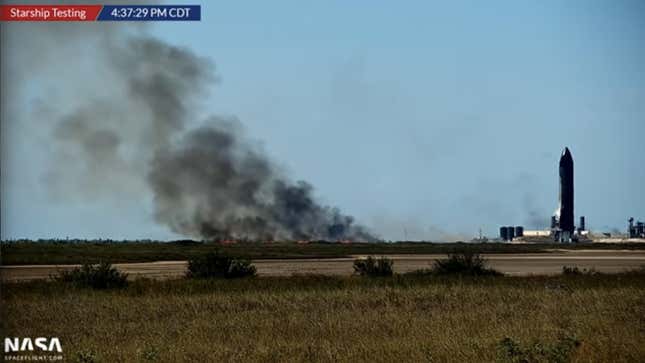
SpaceX performed a static fire test of a prototype Starship rocket on Thursday, in which all six raptor engines were engaged. The eight-second test appeared to go well, save for the problematic brush fire that ensued.
Starship prototype 24 is currently undergoing tests at SpaceX’s Starbase facility in Boca Chica, Texas. SpaceX is preparing the upper stage for an upcoming orbital test of the fully integrated Starship system. During yesterday’s static fire test shortly after 5:30 p.m. ET, the six Raptor engines created a monstrous roar and kicked up a tremendous amount of smoke and dust. After the material settled and the Starship launch pad reemerged, it became clear that several patches of grass in the area were burning.
Video of the scene, as captured by NASASpaceflight (the static fire test starts at 5:35:00 in the video above), showed an unusually tall fire near the rocket, and wider angles revealed brush fires several hundred feet from the stand. Superheated debris from the test even reached a SpaceX dumpster, setting its contents on fire, according to Teslarati. The fires, which affected a protected habitat, required fire crews to come in and fight the flames.

A prior test on August 9 saw only two of prototype 24’s Raptor engines put into action, in what was a subdued version of Thursday’s full-scale test. During the previous day, on August 8, SpaceX performed a limited static fire test of a Starship booster prototype, moving the company closer to an actual orbital launch. SpaceX CEO Elon Musk envisions the fully stacked two-stage Starship rocket as a platform for delivering humans and cargo to orbit, the Moon, and Mars.
Teslarati estimates that Thursday’s six-engine test produced 1,380 tons of thrust, the most ever for a test done at Starbase. And at eight seconds, it was also one of the longest static fire tests done at a Starship test stand.
With great power comes great responsibility, however, and SpaceX is not rising to the challenge; the company, as Teslarati points out, is clearly not taking the necessary precautions to prevent fires near the launch pad and is instead relying on an inadequate spray nozzle and high-temperature concrete:
Most likely, eight long seconds of blast-furnace conditions melted the top layer of surrounding concrete and shot a hailstorm of tiny superheated globules in almost every direction. Indeed, in almost every direction there was something readily able to burn, a fire started. In several locations to the south and west, brush caught fire and began to burn unusually aggressively, quickly growing into walls of flames that sped across the terrain. To the east, debris even made it into a SpaceX dumpster, the contents of which easily caught fire and burned for hours.
Eventually, around [10:00 p.m. EDT], firefighters were able to approach the safed launch pad and rocket, but the main fire had already spread south, out of reach. Instead, they started controlled burns near SpaceX’s roadblock, hoping to clear brush and prevent the fire (however unlikely) from proceeding towards SpaceX’s Starbase factory and Boca Chica Village homes and residents.
More serious precautionary measures, such as a water deluge system, would likely prevent this sort of thing from happening. Instead, the tremendous force, heat, and burn length is annihilating the concrete beneath the rocket, resulting in the spread of superheated debris.
The fire crews had no problem dousing the flames, but the fires did affect an environmentally sensitive area that’s home to threatened wildlife. In June, the Federal Aviation Administration completed its environmental assessment of SpaceX’s proposed site expansion at Boca Chica, saying the company can proceed with its plans, but that it must complete around 75 environmental mitigation actions.
Of these actions, SpaceX must implement wildfire prevention measures and also use spray water to suppress dust and air pollution. Given what happened yesterday, these evidently remain unchecked items on SpaceX’s to-do list. Not cool, Elon. Not cool.
More: SpaceX Signs Deal With NASA to Provide 5 More Crewed Trips to the ISS.